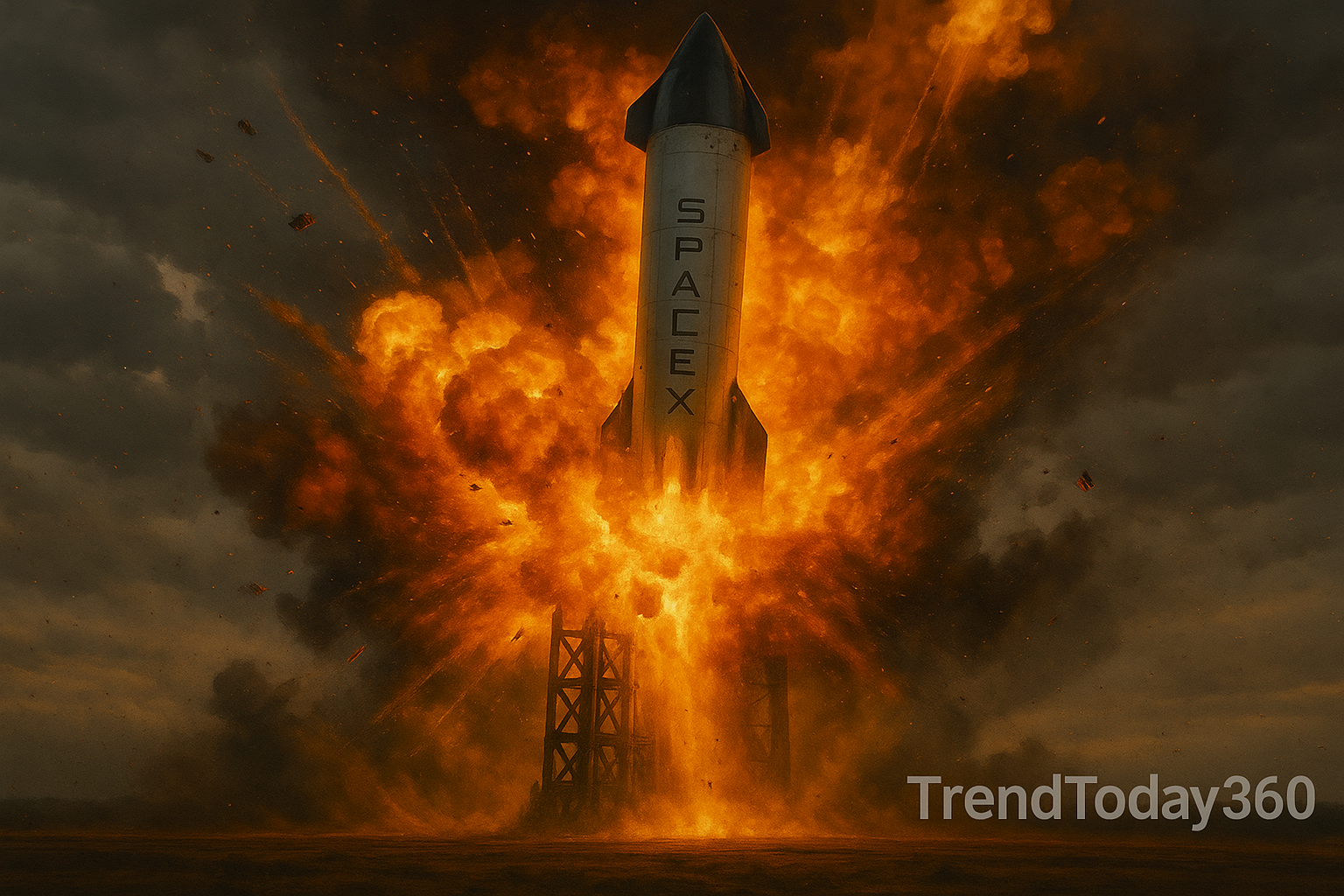A fiery explosion rocked SpaceX Starbase testing site in Massey, Texas, on the night of June 18, 2025, destroying the Starship Ship 36 prototype and putting a pause on plans for the rocket system’s anticipated tenth test flight. The blast occurred just before a scheduled static-fire test, shaking the ground and scattering debris across the facility.
Although no injuries were reported and emergency safety protocols were followed, the incident marks a significant setback for Elon Musk’s bold vision of interplanetary travel.
What Happened During the Test of SpaceX Starship?
The explosion took place during final systems checks ahead of a static fire test—a controlled procedure where the rocket engines are fired while the vehicle remains anchored to the ground. These tests are critical to validating performance and safety before an actual flight.
According to eyewitness accounts, a sudden, fiery blast erupted from the test stand shortly after 11:00 p.m. CT. Debris was seen flying through the air, and a large fireball consumed the prototype. The explosion caused immediate chaos across the launch site, with onlookers capturing the dramatic event in real time.
A full investigation is now underway.
SpaceX’s Official Statement
In a formal release, SpaceX confirmed the event and assured the public that safety procedures were in place:
“On Wednesday, June 18, around 11 p.m., a SpaceX Starship at Starbase experienced a major issue during a test stand operation while getting ready for its tenth flight test. Thanks to strong safety rules and a marked safety zone, everyone on-site is safe and has been checked in. Our team at the launch facility is working hand in hand with local authorities to make sure the test site and nearby areas stay safe and secure.”
The company also emphasized that there are no hazards to residents in the surrounding communities and asked the public not to approach the area while recovery and safing operations continue.
What Caused the Explosion of SpaceX Starship?
Initial indications point to a failure involving a nitrogen pressure tank known as a COPV (Composite Overwrapped Pressure Vessel), located in the upper-stage payload section of Ship 36. Elon Musk confirmed on X (formerly Twitter) that the tank “failed below its proof pressure,” indicating a rare and possibly unforeseen structural flaw.
While the full cause remains under investigation, such failures are not entirely unexpected in rapid aerospace development programs, especially those operating at the edge of engineering capability.
A Setback, But Not Unfamiliar
This isn’t the first time a Starship prototype has been lost during testing. SpaceX has experienced several high-profile setbacks throughout the Starship program’s development, including Ship 7’s failure during ascent, Ship 8’s engine malfunction, and Ship 9’s unsuccessful reentry. Each failure, however, has led to meaningful upgrades and insights.
SpaceX is known for its “fail fast, learn fast” approach—intentionally pushing hardware to its limits to identify weaknesses early in the design cycle. While the destruction of Ship 36 is a visible setback, it fits within SpaceX’s strategy of rapidly iterating to achieve breakthroughs in reusable rocket technology.
What Does This Mean for SpaceX Starship Future?
The explosion will likely delay the tenth test flight originally expected later this month. Ship 36 was the designated vehicle for this milestone, which would have tested key capabilities like orbital launch and reentry systems.
SpaceX engineers are now working to:
Telemetry and on-site diagnostics are being thoroughly reviewed to determine the underlying cause.
Modify designs for future Starship prototypes like Ship 37
Though the next test date is currently unknown, SpaceX is expected to resume preparations once investigations conclude and updated hardware is ready.
Local Impact and Safety Measures
We’re grateful for SpaceX’s strong safety measures, which ensured everyone stayed safe and nearby communities were unharmed.. The company has coordinated with local emergency services and law enforcement to maintain a perimeter during clean-up operations. Residents are advised to stay clear of the site for safety reasons.
Starbase, located in the relatively remote area of Boca Chica, Texas, continues to serve as the hub for Starship development and testing. Despite the setback, work on launch infrastructure, tank farms, and future vehicles is expected to continue.
Final Thoughts
Space travel is risky, experimental, and often dangerous. The explosion of Ship 36 is a sobering reminder that pushing the boundaries of technology comes with high stakes. Hows progress is made.
SpaceX’s Starship program is attempting something no other organization has done—build a fully reusable launch system capable of reaching the Moon, Mars, and beyond. Incidents like this contribute valuable insights as we refine and advance our systems.
While the path to space is never smooth, SpaceX’s willingness to learn from mistakes—and keep moving forward—continues to drive the industry toward a future once thought impossible.
Updated By TrendToday360







Leave a Reply